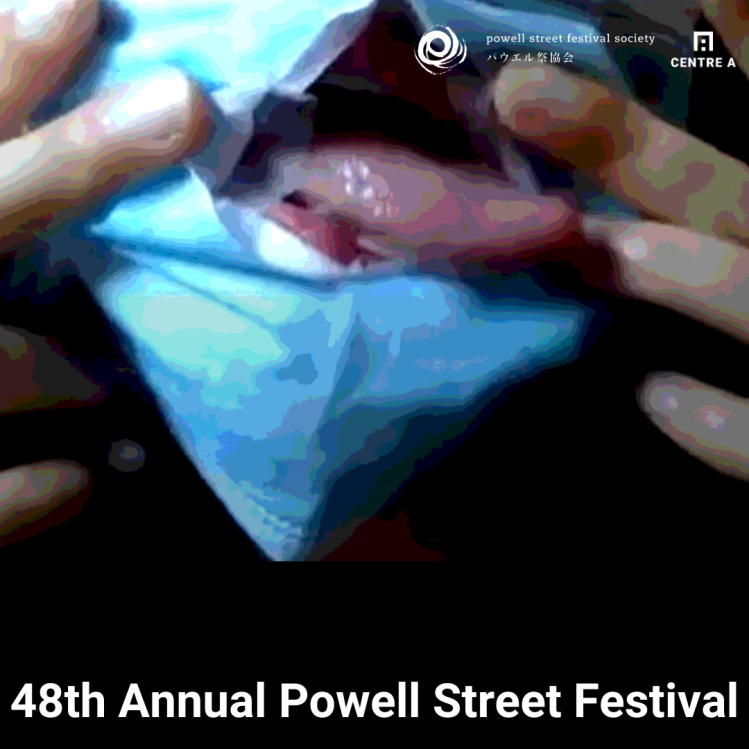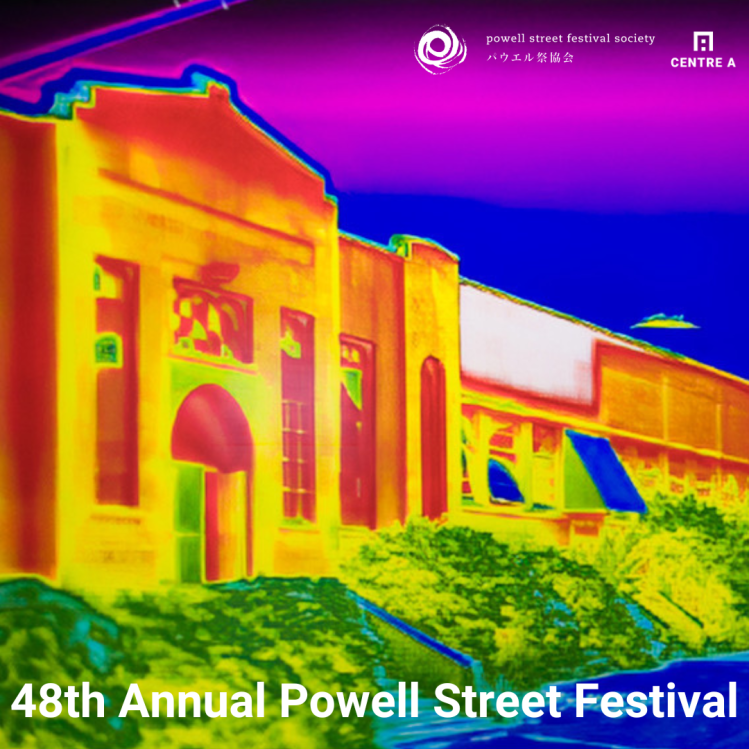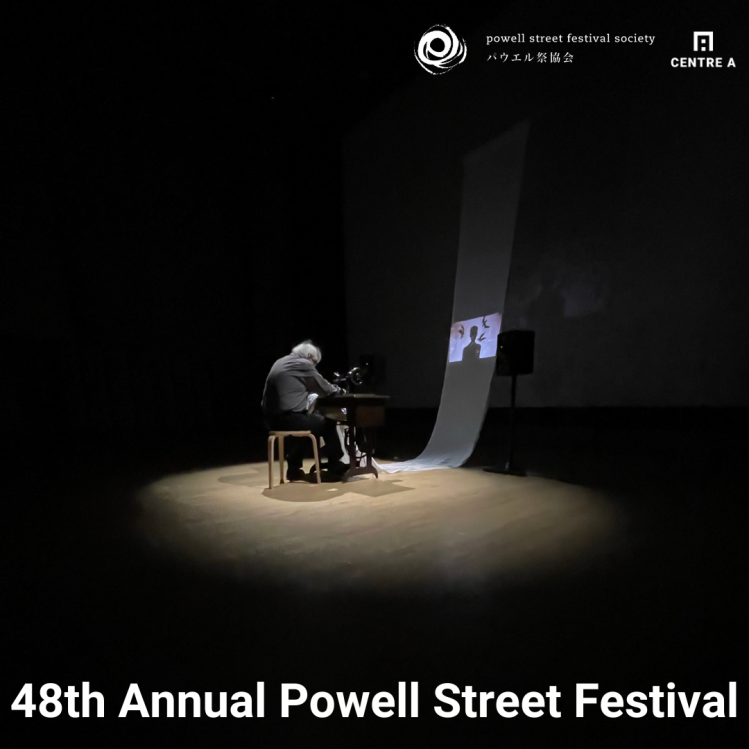August 3 – August 17, 2024
Opening: August 2, 5 – 8 PM
Gallery Hours: Wednesday to Saturday, 12 PM – 6 PM, and Sunday August 4
–
Centre A is pleased to present three concurrent exhibits as part of the 48th Annual Powell Street Festival, which highlight the breadth and depth of Japanese Canadian art and culture:
- A Hydra Journal of the Plague Year by Anju Singh, Valerie Sing Turner, and Derek Chan;
- Hastings Park by Henry Tsang;
- and Kintsugi by Brava Kilo and Annie Sumi (August 3 – 4 only).
Powell Street Festival first took place in 1977 and has since expanded to be one of the largest and longest-running community arts festivals in Canada. Powell Street Festival Society now functions as a non-profit registered charity arts organization based in Vancouver and the Paueru Gai Area—today known as the Downtown Eastside—located on the unceded territories of the Squamish, Tsleil-Waututh, and Musqueam Nations. In addition to its signature event, Powell Street Festival, the Society offers year-round programs and collaborates with local, national, and international organizations, artists, and communities to advance equity and well-being for all.
–
A Hydra Journal of the Plague Year (2024), Anju Singh, Valerie Sing Turner, and Derek Chan
A Hydra Journal of the Plague Year is a multi-channel audio-visual media arts sculptural theatre installation based on the 2021 premiere online production, A Journal of the Plague Year, conceived and directed by Colleen Lanki (1965 – 2023). A Journal of the Plague Year is an English-language translation of the play, Ekibyo ryukoki (1975), written by Terayama Shuji (1935 – 1983) in collaboration with Kishida Rio (1946 – 2003), co-translated by Tsuneda Keiko and Colleen Lanki.
Produced by Visceral Visions and presented by Powell Street Festival Society and Centre A: Vancouver International Centre for Contemporary Asian Art, in association with Tomoe Arts Society and Vancouver Asian Canadian Theatre.
Artist Biography
Anju Singh is an experimental composer, multi-instrumentalist, and video/media artist. By exposing and interrogating texture using methods of deconstruction and reanimation, her work repurposes and contextualizes materials in new compositional environments to bring contrasting themes and dynamics together, centering experimentation and boundary pushing work. She has presented her work an performed across Canada, in Europe, Brazil, Japan, Mexico, and the US.
Derek Chan grew up in colonial Hong Kong. An award-winning playwright, director, theatre maker & performer, Derek is the Managing Artistic Director of Vancouver Asian Canadian Theatre. He was also a co-founder of rice & beans theatre. Derek was a National Arts Centre English Theatre Artist in Residence (19/20). His solo show, Happy Valley (2023) was selected for Spotlight Canada at the Edinburgh Fringe.
Valerie Sing Turner is an award-winning multidisciplinary artist who performs, writes, directs, dramaturges, and produces. She just finished directing a workshop of her play, IN THE SHADOW OF THE MOUNTAINS, and is currently co-directing an animated film adaptation of an operetta, DID I JUST SAY THAT?, for which she also wrote the libretto. She is the founder/Co-Artistic Producer of Visceral Visions and Co-Director for CultureBrew.Art.
The project is funded by Canada Council for the Arts and the City of Vancouver.
–
Hastings Park (2021), Henry Tsang
Hastings Park consists of a series of colour photographs depicting the four remaining buildings in Vancouver where over 8,000 Japanese Canadians were temporarily located and processed prior to being sent off to labour and internment camps during World War II. These buildings are the Livestock Building, the Forum, the Garden Auditorium, and Rollerland. Hastings Park is the site of the Pacific National Exhibition with its baby pig races, livestock competitions, mini donuts and demolition derby. Since it first opened in 1910, its buildings housed only animals, with the one exception of Japanese Canadians in 1942.
The images were created with a construction industry thermal imaging camera that employs infrared scanners that measure the heat signatures of objects and translates those heat signatures into an image where the higher heat signatures are made brighter and easier to see. Originally developed for military use during the Korean War, thermal imaging cameras have since been used by building construction technicians to identify heat leaks or structural weaknesses, by firefighters to see through smoke, by medical practitioners to monitor physiological activities such as fever, and by law enforcement for surveillance activities. Each colour in the photographs represents a different temperature, as opposed to a different frequency of light reflected off the surface of things, which is how human eyes function.
The thermal imaging camera functions as a medium through which the buildings of Hastings Park are asked, “Do you remember the time when people lived inside you? If so, are there any traces left behind? What’s beneath your surface? What else might we uncover?” The intention was to use such a camera to expose these buildings in a new light.
Artist Biography
Henry Tsang is an artist and occasional curator who explores the spatial politics of history, cultural translation, community-building, the mobility of people, capital, values, desires, and food in relationship to place. His projects employ video, photography, interactive media, convivial events, and language, in particular, Chinook Jargon, the North American west coast trade language. Presentations take the form of gallery exhibitions, pop-up street food offerings, 360 video walking tours, curated dinners, ephemeral and permanent public art. Henry is the creator of 360 Riot Walk, a 360 video walking tour of the 1907 Anti-Asian Riots, and author of White Riot: The 1907 Anti-Asian Riots in Vancouver (Arsenal Pulp Press). He is a past recipient of the VIVA Award and is an Associate Dean at Emily Carr University of Art & Design.
Photo Courtesy of Henry Tsang
–
Kintsugi (2022), Brava Kilo and Annie Sumi
“Quiet now, there is not a thing besides the low, humming sound of the body
In my mouth, chewing on the words
I cannot speak to them out loud until I’m ready”
The Japanese practice of kintsugi honours and celebrates the repair of what was once broken. This installation takes the fragmented pieces of self, story and culture, and attempts to reassemble them into something new through song. Kintsugi invites the user to create space to reflect on their own relationship to ancestry and examine how that relationship evolves over time.
Created by mixed-race musicians Brava Kilo and Annie Sumi, Kintsugi is an anti-racist, interactive, multi-disciplinary art installation reflecting on racial identity, healing ancestral trauma, and the fragmented history of the Japanese Canadian internment. The audience can pump the foot treadle of the heirloom sewing-machine to reveal the hidden depth of the installation: a cycle of songs and videos weaving the past into the present.
The visuals are an overlapping collage of landscape video footage, cut-up old letters written by the artists’ ancestors, and playful animations created with shadow puppeteers Mind of a Snail. The projections incorporate present-day footage of two former WWII internment camp locations – one where Kobayakawa’s father was born, and the other where Sumi’s grandfather spent his youth.
The music contains archival recordings of Choichi Hando Sumi reading his haiku poetry, percussion sounds created from a boat built by Kobayakawa’s ancestors’, and lyrics composed entirely from the Government of Canada’s correspondence with the artists’ ancestors listing the belongings that were auctioned off during their internment. Directly confronting the experience of reorienting in a post-internment Canada, Kintsugi brings music into the imposed silence of trauma.
The artists are grateful for the support of their Ancestors, the Japanese Canadian Cultural Centre, the Ontario Arts Council, the Canada Council for the Arts, Mind of a Snail, CBC Radio, Landscapes of Injustice, and their friends and families.
Artist Biography
Composer & multi-instrumentalist Brava Kilo creates music in many ways. Using the nom-de-plume Brava Kilo, he released the unique instrumental album Hang On, You Demons! and co-created Kintsugi, a multi-disciplinary, interactive, installation-art piece, which premiered in 2022 at the Japanese Canadian Cultural Centre. As a founding member of The Creaking Tree String Quartet, he released 4 albums featuring his compositions resulting in 4 JUNO Award nominations. He has toured the world for over a decade as bassist and music director for platinum-selling singer-songwriter Serena Ryder. Brava also composes for films, recently completing the score for Jackals & Fireflies, directed by Oscar-winner Charlie Kaufman.
Annie Sumi is an ethereal-folk artist with an ability to capture the subtleties of nature and weave them into melodies. Her latest collection of songs, Solastalgia, was released in October, 2021. Since the release of her debut album, she has received nominations for “New/Emerging Artist of the Year” (Canadian Folk Music Awards, 2018), “Best Singer-Songwriter” (TIMAs, 2015), “New/Emerging Artist of the Year” (Hidden Roots Collective, CFMAs, 2017), and more. With the support of the Ontario Arts Council, Annie has carried these landscapes of sound across Canada, parts of the U.S., and central Europe.
This project is funded by Canada Council for the Arts and Ontario Art Council.
______________________________________________________________________________________________________













